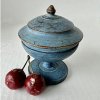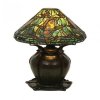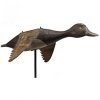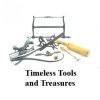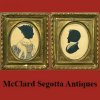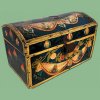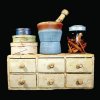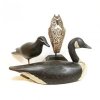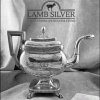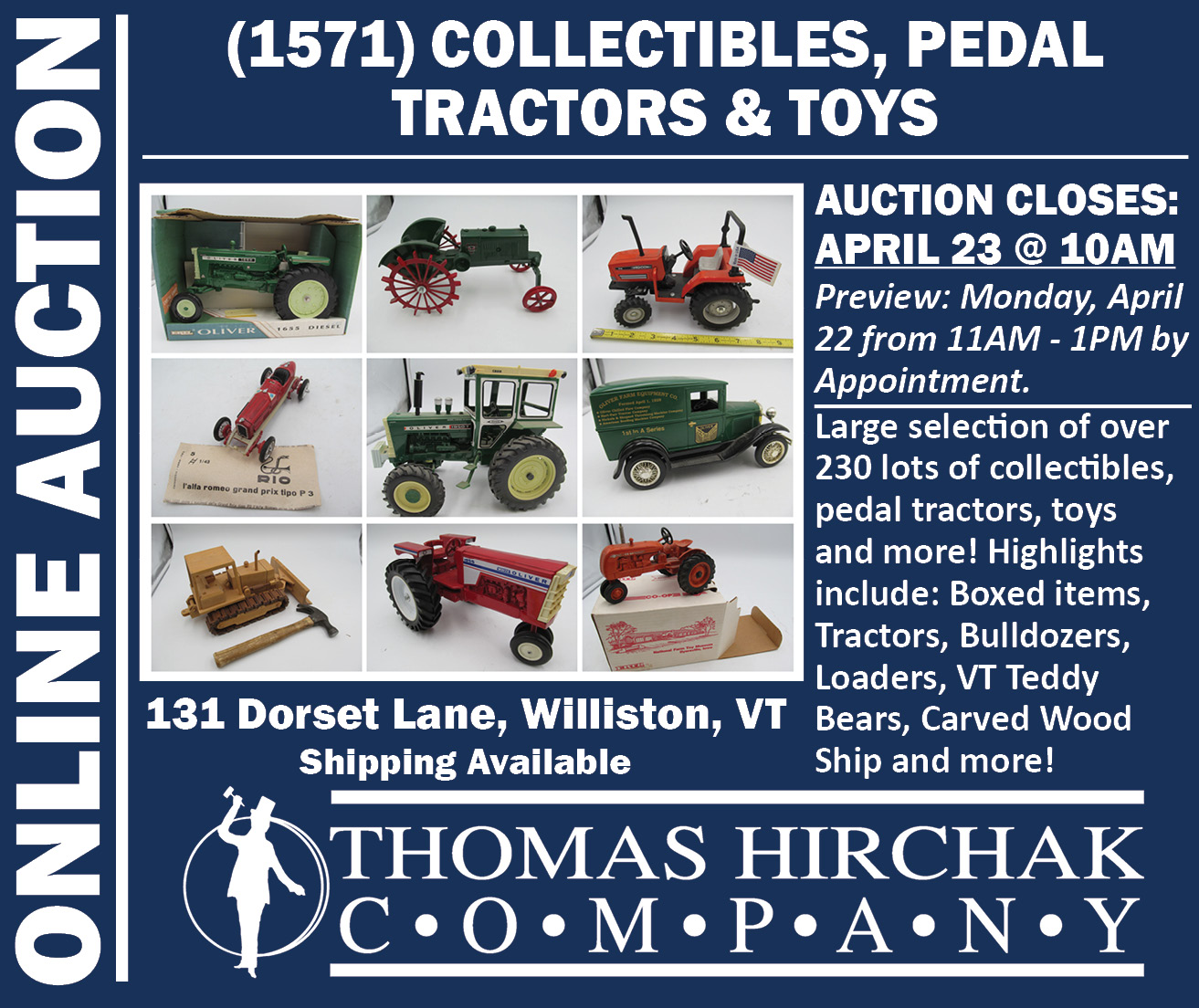Changes to Zoar Antiques Show Bring Great Results
July 30th, 2017
Zoar Harvest Festival and Antiques Show, Zoar, Ohio
New weekend, new look, new record attendance—that about sums up what took place July 29 and 30 when the 44th annual Zoar Harvest Festival and Antiques Show was held in Historic Zoar Village in Zoar, Ohio.
Show manager Steve Sherhag took over managing this event a few years ago and has dedicated a great deal of time and effort into making Zoar the best country show in Ohio. Sherhag said, “When I first became manager, Zoar was held on the same weekend as the New Hampshire shows, which was a bit frustrating. There were dealers who did New Hampshire that also wanted to set up at Zoar.”

Deborah Fisher of Lebanon, Ohio, put together this vignette along the back wall of her booth. Shown is a circa 1800 miniature cherry chest with a drawer, priced at $775. The chest is signed along the front by the maker, “J.O. Brystle.” The circa 1800 rocking horse wearing its original worn surface was $775. These both sit atop an 1800s walnut sugar chest in its original surface tagged $1200. The beautiful staved bucket in original red and blue paint was $175, and the golden German mohair bear with glass eyes was priced at $385. It sits in a Chester County, Pennsylvania, youth chair, with its original seat, that was available for $325, and the Irish Chain quilt on the wall was tagged $525.

Steve Sherhag, show manager of the Zoar Antiques Show, held in Zoar, Ohio, is on the ball. The dealer space shown here—actually three full spaces—filled by Don and Marta Orwig of Corunna, Indiana, was what patrons could see while standing in line to enter the show. The oil on canvas painting of a hay wagon being pulled by two oxen while two men pitch hay was by artist Herman Parker from Ohio ($775), while the nine-drawer galvanized bin unit was $575. Toledo stools and chairs are all the rage right now, and the two shown here were $125 each. The impressive folk art log home was priced at $225, and the folk art mechanical donkey could be yours for $2850.

Tim Chambers of Missouri Plain Folk, Sikeston, Missouri, leaned up against a tall Indiana or Illinois jelly cupboard ($1250) with old blue paint and with old green door panels. Chambers, along with his wife, Charline, had a nice mix of interesting items, including an 18th-century chair constructed similar to a mini settee. Found in New York state, this piece was $495, while the crossbuck table, a Pennsylvania item, with mortised construction and great original paint, could be had for $1250. The orange game board and double-sided tin “Cut Flowers” sign were both priced at $350. It makes sense that this couple’s dealer space would house a game board, as their interest in handmade painted game boards culminated in the publishing of The Art of the Game, a full-color hardbound book showcasing the collection of Selby Shaver of Chapel Hills, South Carolina.
Solution. Sherhag met with the Zoar Harvest Festival Committee and pleaded his case. The committee was open to the change, and it ended up that the artists displaying in the Harvest Festival’s Artisans Tent also were glad of the earlier date.
“As far as the antiques dealers, I was able to get some great new additions, and many patrons said there was a definite increase in the quality of items being offered this year. We had a dealer with wonderful old toys. Another whose smalls focused on sewing items. Folk art was prevalent. The date change made a difference, and it was reflected in the dealers who attended, and the quality of merchandise offered for sale,” Sherhag stated.
The total attendance this year topped the 2700 mark. “That’s just insane,” Sherhag said with a smile, adding, “As unbelievable as it is to say, on Saturday, the huge crowd was actually a problem.”
Say what?
“At one point it was so crowded in the tent on Saturday morning that patrons left the show and came back later just so they could actually get into the dealers’ booths to see what was for sale,” Sherhag explained. “I am working on resolving this aspect for next year by possibly having two medium-size tents as opposed to one large tent.”
With that said, it should be noted that Sherhag did add a 40' x 40' tent that was utilized by a single dealer. “It was big enough to hold three booths, and Don and Marta Orwig of Corunna, Indiana, filled it to the brim.” This smaller tent was attached to the large tent and acted as an entry venue into the show.

Duane F. Watson of Doc’s Crocks, Ashland, Ohio, had an extensive display of stoneware in his dealer space at Zoar. The circa 1820 northeast Ohio tulip-incised jug at left was priced at $750, while the circa 1810 Crolius, New York City, jug at far right was tagged $995. At center is a Goodwin & Webster, Hartford, Connecticut, jug decorated with a folky incised sailing ship for $995. The circa 1880 six-gallon churn by J. Burger, Jr. of Rochester, New York, decorated with an outstanding cobalt seated lion and whimsical tree, was priced at $14,500.

Howard Antiques and Primitives had this “E.E. Pease Jeweler” double-sided trade sign for $1100. It was found in Carlisle, Pennsylvania. The “B. Unwin / Butcher Chesterfield” sign was priced at $275.

Working around the tent pole, Rush Antiques, Rochester, Michigan, set up a pin-top country worktable ($2825) at center surrounded by six paint-decorated and stenciled chairs ($900). The pleasing smaller size Empire desk made of mahogany veneer over pine ($950) was circa 1820. The poplar six-board decorated blanket chest ($2200) has pinned construction and its original feet and till. Other highlights of this booth were a circa 1820 Regency Pembroke table ($650); a circa 1899 painted tin countertop store-keeper ($525); and a miniature child’s Hoosier oak cupboard ($640).
 So what was selling? “Lots of smaller pieces went out the door,” Sherhag stated, “as did a decent amount of furniture. It was a typical show. Some dealers blew it out of the water saleswise; others were middle of the road; and still others didn’t sell all that well. I think the dealers who sell the most bring a wide variety of items in a wide range of prices, that something-for-everyone way of thinking.”
So what was selling? “Lots of smaller pieces went out the door,” Sherhag stated, “as did a decent amount of furniture. It was a typical show. Some dealers blew it out of the water saleswise; others were middle of the road; and still others didn’t sell all that well. I think the dealers who sell the most bring a wide variety of items in a wide range of prices, that something-for-everyone way of thinking.”
Sherhag also utilized the historic restored Zoar schoolhouse where five dealers were housed. Yes, it is away from the main body of the show, but the schoolhouse is air conditioned! Thankfully the weather for the weekend was on the cooler side, so being inside the tent was comfortable as well.
“The number of dealers who participated was up this year,” Sherhag noted. “There were sixty-five booths used by sixty dealers, with nine of those being dealers new to the show.” Sherhag stated that there has been some turnover where dealers were concerned, not because they decided Zoar was not to their liking, but more because dealers are retiring, moving, or dealing with an illness.
Sherhag also stated that the artisans show, which is part of the Zoar Harvest Festival and Antiques Show, greatly contributed to the success of the antiques show. “The Zoar Harvest Festival gives the most bang for your buck of any event I know of, in my opinion,” Sherhag noted. For $9, patrons get a wristband that affords them access to the antiques show tents, the Artisans Tent, and all the museums that make up the Historic Zoar Village.
Another bonus to those attending the show this year was the fact that the Historic Zoar Village was celebrating its bicentennial. The history of Zoar is briefly explained on the village’s website (www.historiczoarvillage.com). Zoar was founded in 1817 by a group of over 200 German Separatists who sought refuge from religious persecution in their homeland. They separated from the Lutheran Church, the official church of the German state of Württemberg, rather than compromise their convictions, and left friends, family, and homeland behind to seek religious refuge in America. The group thrived for more than 80 years, which makes Zoar one of the most successful communal settlements in American history. Today Zoar village includes around 75 families living in homes built from 1817 to the present.

Though items in the dealer space of John Kolar were few in number, they were an impressive lot. Take, for example, this simple display of fraktur and a wagon. The 1890s child’s #44 Express wagon was made by Paris Manufacturing in South Paris, Maine. It was $1450. The fraktur at upper left is a birth certificate for Jacob Brong, dated August 28, 1822, Donegal Township, Lancaster County, and confirmed January 26, 1839, with the witness being Johan Sell. Kolar noted that this fraktur, priced at $2250, is interesting as it includes the names of two gunsmith families—Brong and Sell. The lower left example is an Abraham Huth fraktur of strawberries, tulips, and pots of flowers tagged $5200. It is a birth certificate for Johanes Knub, December 29, 1814, Lebanon County. And the fraktur at lower right, priced at $2800, is signed by the artist, Martin Brechall. It is a birth certificate for Johannes Knepper, February 25, 1813, Berks County, Center Township.

There were many interesting smalls found at the Zoar Harvest Festival and Antiques Show this year. Wilhide’s Antiques, Shippensburg, Pennsylvania, brought along a nice selection of very graphic, early boxed games ranging in price from $50 to $100. Other items seen in this display include a red piggin, $245; car flag holders, $125 each; a white bench, $65; a six-drawer box with porcelain knobs, $245; a firkin in old red, $165; a wooden carrier painted blue, $95; a small firkin in old green paint with a bail handle, $215; and a white-painted sign with black lettering reading “New Home / Morgan Street / For Sale,” $95.

Kay and Bill Puchstein of Lakeland, Florida, offered an impressive booth setting. The 5' long pumpkin-colored painted dry sink front and center was $2200. We loved how the zinc lining runs up the back of the piece. The Shaker child’s rocker with a slatted seat was $495. The bowls in the dry sink included a blue-gray beehive example priced at $950, while the red and the yellow bowls were $895 each. The small two-door dry sink at back right was 32" high, a usable shallow size, and wore a “SOLD” tag.
The village really was something to see during the 2017 Harvest Festival. Most noteworthy was the updated, extensive Zoar history display found in the Number One House, which is owned by the Ohio Historical Society and is operated by the Zoar Community Association.
Besides all the information provided about the town and its past, this museum is filled with fantastic Zoar items, from furniture and textiles to sewer tile art and historical documents. With the antiques show brimming with outstanding buying opportunities just up the street from the Number One House, antiques enthusiasts were on sensory overload the weekend of July 29 and 30.
“I was very happy with the way the show ran, and I received a lot of compliments from both patrons and dealers about the event,” Sherhag stated. “It is always much appreciated to receive positive feedback. I also see where there is still work to be done, and I plan to address these aspects for the forty-fifth edition in 2018.”
For more information, call Steve Sherhag at (330) 207-2196 or go to (www.historiczoarvillage.com).

Look at this lineup in the dealer space of Comet Lake Antiques, Clinton, Ohio. At far left, the two-piece paint-decorated stepback jelly cupboard with three drawers and two doors was $1295. The red pantry cupboard with one door and four interior shelves was also $1295. Next in line is “the most popular piece in my booth,” according to Mike Christy—a 12-tin pie safe in a gorgeous blue. The tins are punched with a basket design, and the long bottom drawer was a major plus. This safe was $2700. The red Sheraton jelly cupboard is deep and has two huge drawers over two doors; it was priced at $1800.

Kathy and Jeff Graybill of East Waterford, Pennsylvania, utilized the historic Zoar schoolhouse for their dealer display. Offered was a two-drawer, two-board-top table in red, dated 1830, that was $1850. The early plaster eagle was $395, while the rug hanging above it was tagged $295. Taking up one corner of the booth was a long, graphic hooked rug priced at $495. The rug featuring two swans was $495, while the black rug with the central floral design in shades of red and orange with blue was tagged $345. The hooked rug featuring leaf-like graphics was $295, and the large rug at left with a bold Art Nouveau look was $595. A pale yellow bucket bench has wood pegged construction and the elegance of French feet tipped in brownish-red paint. This bench was priced at $295.

Four Friends Antiques, Medina, Ohio, brought great things to Zoar. The 60-hole cubby that created the booth’s backdrop was $595. It had come from the workshop of a dairy farm in Carrollton, Ohio. Two lanterns sitting on top included an early kerosene example priced at $395 and a brass Brooklyn lantern that was $339. The long two-door zinc-lined dry sink wearing chipped blue-gray paint was $1695. The “Roadside Market” sign was found in Creston, Ohio, and was $449. On top of the center table is a child’s blanket box with small turned feet that was $895. And on top of that is a small six-drawer spice chest ($495) with each drawer being labeled with a different spice—cinnamon, pearlash, ginger, allspice, nutmeg, and pepper.
Originally published in the October 2017 issue of Maine Antique Digest. © 2017 Maine Antique Digest



